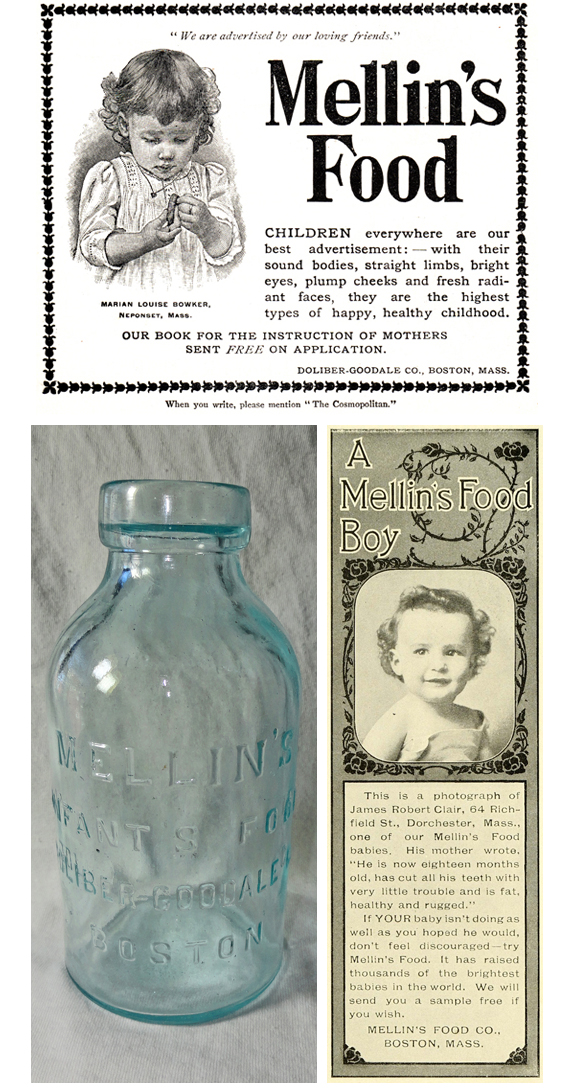Dorchester Illustration 2451 Mellin’s Food
Thomas Goodale of the Doliber-Goodale Co. chose local children for his advertisement. The top illustration is an 1894 advertisement for Mellin’s Food with an illustration of Marian Louise Bowker, Neponset, Mass. The advertisement on the bottom right includes a photograph of James Robert Clair, 64 Richfield Street, Dorchester. The bottle is at the Dorchester Historical Society. The society owns another advertising card with a testimonial: “My little one only two months old, was a mere skeleton. We put him on Mellin’s Food, and it is wonderful to see what a change it has wrought.” April 19, 1888.
Thomas T. Goodale lived at 10 Carruth Street in Dorchester from the time it was built in 1888 until about 1920. He and Thomas Doliber worked for Theodore Mecalf of Boston. The company was the marketer of Mellin’s Infant Food. About 1880 Doliber and Goodale took over the business, which they ran out of 40-43 Central Wharf on the Boston waterfront.
The following is from Goods for Sale: Products and Advertising in the Massachusetts Industrial Age by Chaim M. Rosenberg (2007), 123.
With the beginning of the scientific age, the search for a good alternative to mother’s milk gathered speed. The German scientist Justus von Liebig is credited with being the first, in 1867, to offer for sale an “ideal” infant food. His formula was a blend of cow’s milk, wheat flour, and malt flour, mixed with bicarbonate of potash. Gustav Mellin in England modified Liebig’s formula. Prepared infant food was a boon to working mothers who left their nursing children in the hands of grand-parents during the day. Mellin’s Food for the Infant became popular in the United States. It was marketed by Theodore Metcalf of Boston at the cost of sixty-five cents a container. Around 1880 the agency for Mellins’ baby food was taken over by Thomas Doliber and Thomas T. Goodale, two of Metcalf’s employees. Doliber-Goodale & Co., was located at 40-43 Central Wharf on Boston’s waterfront. Its motto was “ora et labora” (pray and labor). The company advertised Mellin’s Food as “the only perfect substitute for Mother’s milk.” Made from dried malt extract, Mellin’s Food claimed to give the baby “strength and vitality” while preventing colic and constipation. Later, the market for Mellin’s Food was expanded to include the elderly, invalids, and dyspeptics.
The following is from http://www.foodtimeline.org/foodbaby.html
By the 1890s the most popular by far of the powders to be added to milk was Mellins Food, developed in England and manufactured in Boston, whose advertisements claimed that it was “the genuine Liebigs Food,” The best known of the dried-milk products was another European import, Nestles Milk Food, which was manufactured and distributed under license by a New York City firm. Advertisements for various proprietary infant foods because well-nigh ubiquitous by the 1890s….Nestles (“Best for Babies”) said it was better for babies than milk, for “impure milk in hot weather is one of the chief causes of sickness among babies.”…A favorite promotional technique was to offer free samples by mail to the readers of middle-class magazines. Perhaps the most effective with middle-class mothers…were the free handbooks on infant care feeding distributed by the companies. Mellin’s with its own press, was especially active in this field. The handbooks explained the chemistry of milk and feeding in clear but relatively sophisticated language, adding an aura of science to the food they were promoting.

